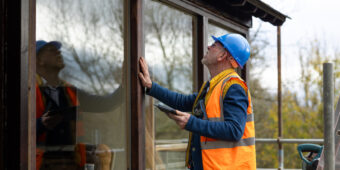Build better relationships
17 Mar 2023, Learn, Prove Your Know How, Technical

A project’s success depends on several relationships. In this article, architect Samantha Zondag details how to nail one of them – that between builder and architect
While there are a number of things we can’t control, such as pandemics and the weather, we can control our approach to site relations.
These include relationships with and between clients, subbies, suppliers and consent officers, to name a few.
But perhaps one of the most important – yet often contentious – is the one between architect and builder. This relationship can be a source of frustration for both parties, but fostering an understanding that you’ll want to continue after the project is completed can be beneficial in more ways than one.
In full disclosure – I’m an architect and hence find the habits of my profession and brain relatively normal, but I am also completely aware that these aren’t necessarily conventional.
Here are some insider tips (verified and tested by my non-architect partner) to help you understand your architect better, so you get the most out of your relationship with them.
Visual vs kinesthetic learning
They say there are three types of learning style: visual, auditory and kinesthetic.
While most builders learn through doing (kinesthetic), the architects I know learn through visualising. This is emphasised during an architects training, where assignments are graded on creativity and aesthetic appeal, and the design and uniqueness of an idea takes precedence.
This visual learning and explaining continues into an architect’s profession,
where collaboration is done through sketching and the output of work is a set of drawings.
Visual learners, and therefore architects, understand through ‘seeing’ instead of being ‘talked to’ or ‘doing’. That leads me to tip number one: use visual aids to get your ideas across to an architect.
While a quick phone call might make sense, backing it up with a photo or a rough scribble will make all the difference to the visual brain of an architect and that on-site problem should clear up in no time.
You might even get a smiley face drawn in return!
Pencil vs power tools
Builders are experts in all types of power tools, whereas an architect uses pencil power to do their work.
Despite the remarkable development in BIM (building information modelling), CAD (computer-aided design) and computer technology over the past decade, there is still nothing like the immediacy of a 2B pencil sketch to explore and convey initial concept ideas.
Again, this is where architects and builders diverge. It is a rare architect who has intricate knowledge of building tools (if you find one, keep them) and generally architects have limited knowledge of power tools, be it brushless or brushed, impact driver or drill. So, while they can skillfully wield a 2B pencil, in most cases a power tool is a foreign concept. Just like builders do not know everything about drawing, architects do not know everything about building, and this is OK.
Which brings me to tip number two: appreciate each other’s strengths/differences. Architects and builders have their own unique strengths, and recognising these within each other and giving them (and their chosen tools) respect is what a great relationship is built upon.
Creative vs practical
No doubt there are times when an architect’s drawing can appear overly complex and a simpler, more practical solution is preferred by the builder. However, this complexity generally stems from the architect’s design intent, as opposed to them attempting to convolute the builder’s workday.
The design intent is the architect’s overall vision for the project, which can be conveyed throughout the drawings in subtle ways. For example, a common datum line amongst openings, the push and pull of volumes to create depth, or hiding gutters within a roofline to get a clean, crisp edge.
It is understandable that each drawing line on a page can look suspiciously similar for someone who hasn’t spent months or years agonising over every detail. But in the architect’s visual mind, each line has meaning. Some lines represent a key design element to be retained at all costs, such as a line to stop water ingress, while others are mere background players for council approval (not so interesting but still important).
A good architect will have put substantial effort into taking all these small details into consideration, so they can create the big picture the client desires. Therefore, omitting or taking shortcuts with the build process can be likened to not following a recipe. It just won’t taste or look the same.
So here is tip number three. Sitting down with the architect at the start of the project (or even during the design stages if early contractor involvement is an option) to understand the design intent is a great idea. It allows the builder to know what the key, non-negotiable elements are and which aspects could be compromised on for more practical solutions.
Open Mind
Architects can be great at mediating between different groups.
They are often the lead consultant and, prior to anything starting on site, must collaborate between clients who want to build their dreams, quantity surveyors pricing dreams into reality, engineers over-engineering the dream, and councils turning dreams into…well…nightmares. Not to mention navigating the well-known issues of lockdowns, market escalation, supply uncertainty and general chaos.
By the time a pack of drawings arrives at the builder, there is likely a whole host of decisions, complications, stops and starts that have occurred.
A drawing pack for a residential new build could take anywhere between six months to two years to produce, and the fact that a drawing pack has made it as far as the builder is a feat in itself.
Having come all this way, the architect (and client) are eager to see the drawings go from conception to completion, and the success herein lies with good communication and an open mind. Understanding from all parties is critical, as there will no doubt be times when either the architect or builder (or client) has screwed up and requires a favour.
Knowing that an architect is a visual learner, prefers a pencil over a power tool, and has given a ton of thought to the design intent of a project should help builders to understand them that little bit better.
The main takeaway, however, is that you are all on the same team – a team that wishes to create a beautiful and functional building for a shared client, within the ever-constant constraints of time and budget.
Samantha Zondag is a registered architect (March (Prof), BAS, ANZIA) with SUNDAY Architects. For any enquiries, she can be reached at samantha@sundayarchitects.co.nz or via sundayarchitects.co.nz
Register to earn LBP Points Sign in
1 Comment
Leave a Reply
You must be logged in to post a comment.




interesting